Activist on “BLACK LIVES MATTER” mural overlay: “It’s something we can all dance to.”
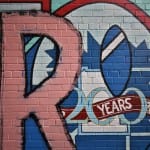
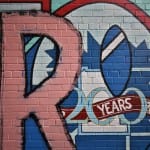

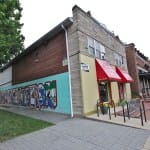
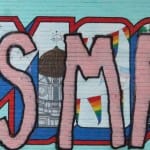
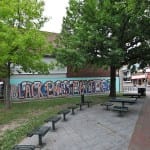
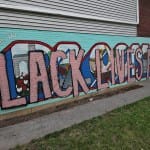
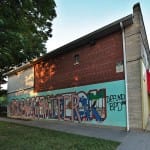
Sometime mid-afternoon on Friday a week ago, an anonymous artist, not commissioned by the property owners, drew new letters across the mural in Bloomington’s People’s Park, spelling out the words: “BLACK LIVES MATTER.”
That’s the way the mural will look for at least the next few months, Bloomington city officials have said. And some local activists would like the wall to be preserved as it is.
Indiana University professor of history Amrita Chakrabarti Myers told The Square Beacon: “I would prefer to see it left the way it sits now—as a historian, but also as a social justice activist.” Myers is a member of BLM B-town’s core council.
Bloomington’s assistant director for the arts, Sean Starowitz, told The Square Beacon that the possibility of preserving the “BLACK LIVES MATTER” lettering is not being ruled out. But that outcome would have to be the result of the public process he’s looking to start with the city’s art commission, which next meets on July 8.
The unauthorized contribution to the mural coincided with Juneteenth, the holiday celebrating the emancipation of slaves in United States.
It also came in the context of nationwide and local demonstrations, prompted by Minneapolis police killing of George Floyd, a 46-year-old Black man, along with other recent police killings of Black men and women. Floyd was killed on May 25 by Minneapolis police officer, Derek Chauvin, when the police officer pinned Floyd down with a knee-on-neck hold.
The message “Defund BPD” (Bloomington Police Department), spray-painted into a blank light-blue background field in the upper right of the People’s Park mural, has been painted over.
In the short term, the city of Bloomington won’t be trying to remove the “BLACK LIVES MATTER” lettering, for at least a couple of reasons. One is that the approach of high-pressure washing, which can work for latex layered over oil-based paint, won’t work in this case, according to Bloomington’s assistant director of the arts, Sean Starowitz.
“It’s latex and latex, and the damage would be a complete redo,” Starowitz said. The 2017 mural, done by artist Eva Allen, wasn’t clear-coated or covered in an anti-graffiti coating, Starowitz said.
A second reason is that the agreement between the artist and the city ends in August, which points to the city’s intention all along to cycle through to another mural after a few years. Under that agreement, if the city wanted to paint over the mural, the artist would have 30 days to “remove” the mural—based on the Visual Artists Rights Act. Starowitz described the law as designed to protect conceptual and intellectual rights.
So there’s little interest in trying to address the current condition of the mural except in the context of planning for the next mural.
The next mural, Starowitz told The Square Beacon, would likely use a request for qualifications (RFQ) process, as opposed to a request for proposals (RFP). That would allow the selection of an artist first, before a specific work is proposed. Starowitz wants the budget for the next mural to be bigger than the one Eva Allen had.
Allen was paid $1,450 to create the work. The Bicycle Garage, which owns the wall where the mural is painted, contributed $200 dollars for materials, Starowitz said. Starowitz thinks a budget between $3,000 and $5,000 might be possible for the next mural.
The Bicycle Garage, Starowitz said, ultimately has a say in the future of the mural.
Starowitz told The Square Beacon that the politics of public spaces like Bloomington’s People’s Park is complicated. The history of the park is “rich, complex, and traumatic,” Starowitz said, including the 1968 firebombing of the Black Market that previously stood there.
More recently, Starowitz said, the unveiling of the current mural three years ago came at a time when the city was discouraging use of the park by those without permanent homes and moving them out of the area. So the mural’s slogan, “You belong here!” was criticized as ironic. He himself was called an “art washer,” Starowitz said.
Given the park’s history, the call for artists would go out to BLM B-town, Neal-Marshall Black Culture Center, First Nations Educational & Cultural Center, among others, Starowitz said.
The wording for the call would say the city is particularly interested in hearing from artists from traditionally underrepresented communities and that the applicants would be evaluated based on how well they could meet the objectives and goals of the project, according to Starowitz.
Jada Bee, who’s a board member of Democracy for Monroe County and a member of BLM B-town’s core council, told The Square Beacon, she thinks the mural should be left in its current condition.
Jada Bee added: “Whatever happens, it needs to be a Black artist calling the shots.”
“It should be sanctified as a Black art space. The artist should be given free rein in the creative process and the city should not be able to censor it. Any kind of change should from a Black artist working with the Black community,” Jada Bee said.
For Myers, the historian, the two layers of the mural now tell the story better than any fresh mural could. “A fresh, new mural would do a disservice to the layered historical struggle,” she said. “This country is rooted in white supremacy,” Myers said, “and we have been screaming ‘Black Lives Matter’ for centuries, but none one listened.”
Myers called the present a “revolutionary moment.” She said that to replace what is now a two-layered mural would lose the story of the struggle. The two-layered mural now tells all at once a story of competing narratives, Myers said.
In addition to the historical value of preserving the “BLACK LIVES MATTER” lettering, Jada Bee sees artistic merit in it.
Other have commented on the fact that the letters seem to reflect thoughtful, intentional choices. They’re wedged between the existing text, which is left uncovered: “Welcome to” in the upper left and “You belong here!” in the lower right. The mural now reads in sum: “Welcome to BLACK LIVES MATTER you belong here!” The shapes of the letters seem to echo the shapes in the letters of the word “Bloomington” in the original mural.
What about the choice of fill-color for the letters? Could the Caucasian-flesh-color be analyzed as a part of an ironic commentary? That wasn’t anything that occurred to Jada Bee. She told The Square Beacon that when she first saw the lettering, she thought, “Oh, they used pink, so it’s ‘Queer Black Lives Matter!'”
Jada Bee told The Square Beacon she grew up watching various graffiti artists in Bloomington. Even graffiti tagging—when someone is just painting their stylized name in a public space—is artistic social commentary, she said: “It takes a corporate-city-state sponsored space and says, ‘I am here as well.'”
The “BLACK LIVES MATTER” lettering over the top of the mural “took a meaningless picture about culture and diversity and turned it into something true,” Jada Bee said.
On the question of whether to leave the letters intact or to paint over them, Jada Bee said it made her recall years ago how a local business had a mural that showed a group of people dancing—mostly white people. Someone spray-painted onto the mural stenciled letters: “It would take us all.” The business owners painted it over. It was re-stenciled. Back and forth it went. Eventually, the business owner just left the words, Jada Bee said.
The “BLACK LIVES MATTER” lettering could be handled like the stenciling on the mural of the people dancing, Jada Bee said. The mashup of the original People’s Park mural with the new “BLACK LIVES MATTER” lettering is now like a mixed tape, Jada Bee said: “It’s something we can all dance to.”




Comments ()